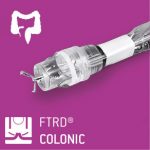FTRD® System: EFTR superior to ESD
A comparison study of patients with colonic neoplastic lesions ≤ 30 mm, who underwent either EFTR or ESD, showed significantly higher technical success rate (92 vs 74 %, p = 0.01), higher R0 (85 vs 62 %, p = 0.01) and believed curative resection rate (75 vs. 56 %, p = 0.01), shorter procedural time (26.4 ± 11.0 min vs 90 – 240 min), and significantly less complications (13 vs. 40 %, p = 0.002) in the EFTR group.
P. Falt et al., University Hospital and Faculty of Medicine, Palacký University, Olomoue, Czech Republic, conducted a study comparing a prospectively followed EFTR cohort to a retrospective ESD cohort in the setting of a single tertiary endoscopy center with the aim to evaluate efficacy and safety of EFTR in the treatment of colorectal lesion ≤ 30 mm.
Overall 52 patients in the EFTR group and 50 patients in the ESD group were treated between 2015 and 2018. Age and sex distribution were comparable. However, there were significant differences in morphology, mean size, and location of lesions. Local residual neoplastic lesions dominated in the EFTR group (54 %) while type 0 – Iia + IIc (LST-NGPD) lesions prevailed in the ESD group (56 %). Mean size was significantly smaller in the EFTR group (15.6 ± 5.1 vs 21.7 ± 6.5 mm). Lesions treated in the EFTR group were evenly distributed throughout the colon and 57 % of them were localized proximally to the lienal flexure. Most lesions treated by ESD were in the rectum (64 %) and only 10 % above the lienal flexure. Histological type of the lesions was almost identical in both groups including the rate of submucosal invasive cancer (29 vs 28 %).
Technical success was significantly more often achieved in the EFTR group (92 vs 74 %, p = 0.01) as well as R0 resection (85 vs 62 %, p = 0.01) and curative resection (75 vs. 56 %, p = 0.01). Significantly less complications occurred in the EFTR group (13 vs. 40 %, p = 0.002), mainly due to a high incidence of electrocoagulation syndrome in the ESD group (24 vs 0 %) and higher incidence of perforation. Total procedure time was substantially shorter in the EFTR group (26.4 ± 11.0 min vs 90 – 240 min). Results of follow-up colonoscopy were known in 76 % of the EFTR and 48 % of the ESD group. Local residual neoplastic lesions were detected numerically more often in the EFTR group (12 vs 5 %, p = 0.12). No patient died during the study and follow-up.
The authors concluded that compared to ESD, EFTR has a significantly higher technical success rate, higher R0 and curative resection rate, and shorter procedure time. In the EFTR group, there were significantly less complications but a higher incidence of local residual neoplasia. Further research including randomized trials is needed.
Endoscopic full-thickness resection versus endoscopic submucosal dissection in the treatment of colonic neoplastic lesions ≤ 30 mm – a single-center experience
Falt P, Zapletalová J, Urban O.
Surg Endosc
doi.org/10.1007/s00464-021-08492-0
 |
 |


 English
English  Français
Français 